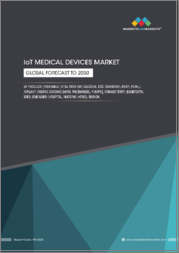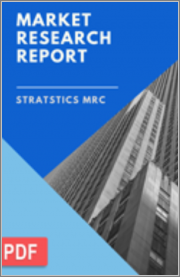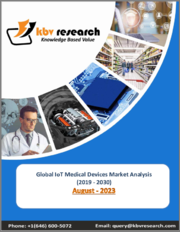
|
시장보고서
상품코드
1608157
세계의 IoT 의료기기 시장 : 제품 유형, 접속 기술, 최종 사용자별 예측(2025-2030년)IoT Medical Devices Market by Product, Type, Connectivity Technology, End-User - Global Forecast 2025-2030 |
||||||
IoT 의료기기 시장은 2023년에 438억 4,000만 달러로 평가되었고, 2024년에는 489억 7,000만 달러에 이를 것으로 예측되며, 복합 연간 성장률(CAGR) 12.80%로 성장하여, 2030년에는 1,019억 3,000만 달러에 달할 것으로 예상됩니다.
IoT 의료기기의 응용 범위는 바이탈 사인 모니터링에서 원격 수술 실현에 이르기까지 다양한 의료 제공에 혁명을 가져다줍니다. 환자 관리를 강화하기 위한 실시간 데이터 수집 및 공유를 용이하게 합니다. 대비 효과적인 건강 관리 솔루션에 대한 수요가 증가하고 지속적인 모니터링이 필요한 만성 질환의 만연에 의해 증가하고 있습니다. 케어 전문가가 정확하고 개별화된 케어를 제공할 수 있도록 되어 있습니다. 기술의 진보, 스마트 헬스케어 솔루션의 채용 확대, 정부의 지원 정책 등을 들 수 있습니다. 현지 건강 관리 제공업체와 파트너십을 수립하고 IoT 솔루션에 대한 환자와 의료 전문가 모두 교육 하기 위해 투자함으로써 이것을 활용할 수 있습니다. 직면하고 있습니다. 이러한 제약으로 인해 보안 프로토콜과 세계 표준을 준수하기 위해 기업의 협력이 필요합니다.혁신은 배터리 수명 향상, 디바이스 소형화, 보다 스마트한 의사결정 도구 제공을 위한 AI 주도 데이터 분석 개선 등의 분야에서 발전할 수 있습니다. 장치의 원활한 통합을 실현하기 위해 조사에는 헤아릴 수 없는 기회가 있습니다. 이 시장의 성격은 템포가 빠르고, 기술 주도형이기 때문에 새로운 동향이나 기술 변화에 대응하기 위한 지속적인 혁신과 민첩성이 중요하다는 것 가 강조되어, 이것이 IoT 의료기기 분야의 지속적인 사업 성장의 열쇠입니다.
| 주요 시장 통계 | |
|---|---|
| 기준년(2023) | 438억 4,000만 달러 |
| 추정년(2024) | 489억 7,000만 달러 |
| 예측년(2030) | 1,019억 3,000만 달러 |
| 복합 연간 성장률(CAGR)(%) | 12.80% |
시장 역학 : 빠르게 진화하는 IoT 의료기기 시장의 주요 시장 인사이트 공개
IoT 의료기기 시장은 수요 및 공급의 역동적인 상호작용에 의해 변모를 이루고 있습니다. 새로운 비즈니스 기회를 얻는 데 도움이 될 수 있습니다. 이러한 동향을 종합적으로 파악함으로써 기업은 정치적, 지리적, 기술적, 사회적, 경제적 영역에 걸친 다양한 위험을 완화할 수 있으며, 소비자 행동과 이는 제조 비용과 구매 동향에 미치는 영향을 더욱 명확하게 이해할 수 있습니다.
- 시장 성장 촉진요인
- 고속 네트워킹 기술의 대두와 헬스케어에 있어서의 모바일 플랫폼의 보급 확대
- 응급 정보 시스템과 원격 의료 시스템에 대한 수요 증가
- 디지털 헬스 추진을 향한 정부의 이니셔티브의 고조
- 시장 성장 억제요인
- 헬스케어 전문가의 IoT 기술 스킬의 부족
- 시장 기회
- 신제품의 발매와 연동한 기술 진보의 출현
- 자기 운용형 e헬스 플랫폼에의 의존도 증가
- 시장의 과제
- 데이터 보안 문제와 상호 운용성에 대한 우려
Porter's Five Forces : IoT 의료기기 시장을 탐색하는 전략 도구
Porter's Five Forces Framework는 시장 상황경쟁 구도를 파악하는 중요한 도구입니다. Porter's Five Forces Framework는 기업의 경쟁력을 평가하고 전략적 기회를 탐구하는 명확한 기술을 제공합니다. 이 프레임워크는 기업이 시장 내 세력도를 평가하고 신규 사업의 수익성을 판단하는 데 도움이 됩니다. 이러한 인사이트을 통해 기업은 자사의 강점을 활용하고 약점을 해결하고 잠재적인 과제를 피함으로써 보다 강인한 시장에서의 포지셔닝을 확보할 수 있습니다.
PESTLE 분석 : IoT 의료기기 시장에서 외부로부터의 영향 파악
외부 거시 환경 요인은 IoT 의료기기 시장의 성과 역학을 형성하는 데 매우 중요한 역할을합니다. 정치적, 경제적, 사회적, 기술적, 법적, 환경적 요인 분석은 이러한 영향을 탐색하는 데 필요한 정보를 제공합니다. PESTLE 요인을 조사함으로써 기업은 잠재적인 위험과 기회를 더 잘 이해할 수 있습니다. 이 분석을 통해 기업은 규제, 소비자 선호, 경제 동향의 변화를 예측하고 앞으로 예상되는 적극적인 의사 결정을 할 준비가 가능합니다.
시장 점유율 분석 IoT 의료기기 시장 경쟁 구도 파악
IoT 의료기기 시장의 상세한 시장 점유율 분석을 통해 공급업체의 성과를 종합적으로 평가할 수 있습니다. 기업은 수익, 고객 기반, 성장률 등 주요 지표를 비교하여 경쟁 포지셔닝을 밝힐 수 있습니다. 이 분석을 통해 시장 집중, 단편화 및 통합 동향을 밝혀내고 공급업체는 경쟁이 치열해지면서 자신의 입지를 높이는 전략적 의사 결정을 내리는 데 필요한 지식을 얻을 수 있습니다.
FPNV 포지셔닝 매트릭스 IoT 의료기기 시장에서 공급업체의 성능 평가
FPNV 포지셔닝 매트릭스는 IoT 의료기기 시장에서 공급업체를 평가하는 중요한 도구입니다. 이 행렬을 통해 비즈니스 조직은 공급업체의 비즈니스 전략과 제품 만족도를 기준으로 평가하여 목표에 맞는 충분한 정보를 바탕으로 의사 결정을 내릴 수 있습니다. 네 가지 사분면을 통해 공급업체를 명확하고 정확하게 부문화하고 전략 목표에 가장 적합한 파트너 및 솔루션을 파악할 수 있습니다.
전략 분석 및 권장 IoT 의료기기 시장에서 성공을 위한 길을 그리기
IoT 의료기기 시장의 전략 분석은 시장에서의 존재를 강화하려는 기업에 필수적입니다. 주요 자원, 역량 및 성과 지표를 검토함으로써 기업은 성장 기회를 파악하고 개선을 위해 노력할 수 있습니다. 이 접근법을 통해 경쟁 구도에서 과제를 극복하고 새로운 비즈니스 기회를 활용하여 장기적인 성공을 거둘 수 있는 체제를 구축할 수 있습니다.
이 보고서는 주요 관심 분야를 포괄하는 시장의 종합적인 분석을 제공합니다.
1. 시장 침투 : 현재 시장 환경의 상세한 검토, 주요 기업의 광범위한 데이터, 시장 도달범위 및 전반적인 영향력 평가.
2. 시장 개척도 : 신흥 시장의 성장 기회를 파악하고, 기존 분야의 확장 가능성을 평가하고, 미래 성장을 위한 전략적 로드맵을 제공합니다.
3. 시장 다양화 : 최근 제품 시장, 미개척 지역, 업계의 주요 진보, 시장을 형성하는 전략적 투자를 분석합니다.
4. 경쟁 평가 및 정보 : 경쟁 구도를 철저히 분석하여 시장 점유율, 사업 전략, 제품 포트폴리오, 인증, 규제 당국 승인, 특허 동향, 주요 기업의 기술 진보 등을 검증합니다.
5. 제품 개발 및 혁신 : 미래 시장 성장을 가속할 것으로 예상되는 최첨단 기술, R&D 활동, 제품 혁신을 강조합니다.
또한 이해관계자가 충분한 정보를 얻고 의사결정을 할 수 있도록 중요한 질문에 대답하고 있습니다.
1. 현재 시장 규모와 향후 성장 예측은?
2. 최고의 투자 기회를 제공하는 제품, 부문 및 지역은 어디입니까?
3. 시장을 형성하는 주요 기술 동향과 규제의 영향은?
4. 주요 벤더의 시장 점유율과 경쟁 포지션은?
5. 벤더 시장 진입, 철수 전략의 원동력이 되는 수익원과 전략적 기회는 무엇인가?
목차
제1장 서문
제2장 조사 방법
제3장 주요 요약
제4장 시장 개요
제5장 시장 인사이트
- 시장 역학
- 성장 촉진요인
- 헬스케어에 있어서의 고속 네트워크 기술의 대두와 모바일 플랫폼의 보급 확대
- 긴급 정보 시스템과 원격 의료 시스템에 대한 수요 증가
- 디지털 헬스를 추진하는 정부의 대처가 급증
- 억제요인
- 헬스케어 종사자의 IoT 기술 스킬이 불충분
- 기회
- 기술의 진보와 신제품의 발매의 융합
- 자발적으로 운영하는 eHealth 플랫폼에 대한 의존도 증가
- 과제
- 데이터 보안 문제와 상호 운용성에 대한 우려
- 성장 촉진요인
- 시장 세분화 분석
- Porter's Five Forces 분석
- PESTEL 분석
- 정치적
- 경제
- 사교
- 기술적
- 법률상
- 환경
제6장 IoT 의료기기 시장 : 제품별
- 마취기
- 태아 모니터링 장치
- 보청기
- 이미징 시스템
- 이식형 심장 디바이스
- 이식형 심장 모니터
- 이식형 제세동기
- 페이스메이커
- 주입 펌프
- 신경학적 장치
- 환자 모니터
- 호흡기
- 인공호흡기
- 바이탈 사인 모니터링 디바이스
- 혈당 모니터
- 혈압 모니터
- ECG/심박 모니터
- 멀티파라미터 모니터
- 옥시미터
제7장 IoT 의료기기 시장 : 유형별
- 이식형 의료기기
- 거치형 의료기기
- 웨어러블 의료기기
제8장 IoT 의료기기 시장 커넥티비티 테크놀로지
- 블루투스
- 와이파이
- 지그비
제9장 IoT 의료기기 시장 : 최종 사용자별
- 개호 시설
- 가정치료 환경
- 병원 및 클리닉
- 장기 케어 센터
- 노인 홈
제10장 아메리카의 IoT 의료기기 시장
- 아르헨티나
- 브라질
- 캐나다
- 멕시코
- 미국
제11장 아시아태평양의 IoT 의료기기 시장
- 호주
- 중국
- 인도
- 인도네시아
- 일본
- 말레이시아
- 필리핀
- 싱가포르
- 한국
- 대만
- 태국
- 베트남
제12장 유럽, 중동 및 아프리카의 IoT 의료기기 시장
- 덴마크
- 이집트
- 핀란드
- 프랑스
- 독일
- 이스라엘
- 이탈리아
- 네덜란드
- 나이지리아
- 노르웨이
- 폴란드
- 카타르
- 러시아
- 사우디아라비아
- 남아프리카
- 스페인
- 스웨덴
- 스위스
- 터키
- 아랍에미리트(UAE)
- 영국
제13장 경쟁 구도
- 시장 점유율 분석(2023년)
- FPNV 포지셔닝 매트릭스(2023년)
- 경쟁 시나리오 분석
- 전략 분석과 제안
기업 목록
- AMD Global Telemedicine
- Dragerwerk AG & Co. KGaA
- GE Healthcare
- Hill-Rom Holdings, Inc.
- Honeywell International Inc.
- Johnson & Johnson Services, Inc.
- Koninklijke Philips NV
- Masimo Corporation
- Medtronic PLC
- Nihon Kohden Corporation
- Nonin Medical, Inc.
- Omron Corporation
- ResMed Corp.
- Siemens Healthineers International AG
- Stanley Black & Decker, Inc.
The IoT Medical Devices Market was valued at USD 43.84 billion in 2023, expected to reach USD 48.97 billion in 2024, and is projected to grow at a CAGR of 12.80%, to USD 101.93 billion by 2030.
The scope of IoT medical devices encompasses a wide array of applications, from monitoring vital signs to enabling remote surgeries, thus revolutionizing healthcare delivery. IoT medical devices integrate sensors and wireless communication technologies into traditional devices, facilitating real-time data collection and sharing for enhanced diagnostics and patient management. The necessity for such devices has intensified, primarily driven by a rising demand for efficient, cost-effective healthcare solutions and the growing prevalence of chronic diseases requiring continuous monitoring. These devices find applications across hospitals, clinics, and home care settings, allowing healthcare professionals to provide precise and personalized care. Key growth factors influencing the market include advancements in wireless technology, increasing adoption of smart healthcare solutions, and supportive governmental policies. There is a noticeable potential for opportunities in developing regions where healthcare infrastructure is evolving. Businesses can capitalize on this by establishing partnerships with local healthcare providers and investing in educating both patients and healthcare professionals about IoT solutions. However, the market faces challenges such as stringent regulatory approvals, concerns over data privacy and security, and the need for interoperability among devices. These limitations necessitate a concerted effort from companies to address security protocols and compliance with global standards. Innovation can thrive in areas like enhanced battery life, miniaturization of devices, and improved AI-driven data analytics to offer smarter decision-making tools. There is immense opportunity in research for achieving seamless integration of IoT devices into existing healthcare frameworks. The nature of this market is fast-paced and technology-driven, underscoring the importance for continuous innovation and agility in responding to emerging trends and technological shifts, which are key to sustainable business growth in the IoT medical devices sector.
| KEY MARKET STATISTICS | |
|---|---|
| Base Year [2023] | USD 43.84 billion |
| Estimated Year [2024] | USD 48.97 billion |
| Forecast Year [2030] | USD 101.93 billion |
| CAGR (%) | 12.80% |
Market Dynamics: Unveiling Key Market Insights in the Rapidly Evolving IoT Medical Devices Market
The IoT Medical Devices Market is undergoing transformative changes driven by a dynamic interplay of supply and demand factors. Understanding these evolving market dynamics prepares business organizations to make informed investment decisions, refine strategic decisions, and seize new opportunities. By gaining a comprehensive view of these trends, business organizations can mitigate various risks across political, geographic, technical, social, and economic domains while also gaining a clearer understanding of consumer behavior and its impact on manufacturing costs and purchasing trends.
- Market Drivers
- Rising high-speed networking technologies and increasing penetration of mobile platforms in healthcare
- Increasing demand for emergency information systems and telehealth systems
- Surging government initiatives for promoting digital health
- Market Restraints
- Insufficient IoT technology skills among healthcare professionals
- Market Opportunities
- Emergence of technological advancements coupled with new product launches
- Increased dependency on self-operated eHealth platforms
- Market Challenges
- Concerns regarding data security issues and interoperability
Porter's Five Forces: A Strategic Tool for Navigating the IoT Medical Devices Market
Porter's five forces framework is a critical tool for understanding the competitive landscape of the IoT Medical Devices Market. It offers business organizations with a clear methodology for evaluating their competitive positioning and exploring strategic opportunities. This framework helps businesses assess the power dynamics within the market and determine the profitability of new ventures. With these insights, business organizations can leverage their strengths, address weaknesses, and avoid potential challenges, ensuring a more resilient market positioning.
PESTLE Analysis: Navigating External Influences in the IoT Medical Devices Market
External macro-environmental factors play a pivotal role in shaping the performance dynamics of the IoT Medical Devices Market. Political, Economic, Social, Technological, Legal, and Environmental factors analysis provides the necessary information to navigate these influences. By examining PESTLE factors, businesses can better understand potential risks and opportunities. This analysis enables business organizations to anticipate changes in regulations, consumer preferences, and economic trends, ensuring they are prepared to make proactive, forward-thinking decisions.
Market Share Analysis: Understanding the Competitive Landscape in the IoT Medical Devices Market
A detailed market share analysis in the IoT Medical Devices Market provides a comprehensive assessment of vendors' performance. Companies can identify their competitive positioning by comparing key metrics, including revenue, customer base, and growth rates. This analysis highlights market concentration, fragmentation, and trends in consolidation, offering vendors the insights required to make strategic decisions that enhance their position in an increasingly competitive landscape.
FPNV Positioning Matrix: Evaluating Vendors' Performance in the IoT Medical Devices Market
The Forefront, Pathfinder, Niche, Vital (FPNV) Positioning Matrix is a critical tool for evaluating vendors within the IoT Medical Devices Market. This matrix enables business organizations to make well-informed decisions that align with their goals by assessing vendors based on their business strategy and product satisfaction. The four quadrants provide a clear and precise segmentation of vendors, helping users identify the right partners and solutions that best fit their strategic objectives.
Strategy Analysis & Recommendation: Charting a Path to Success in the IoT Medical Devices Market
A strategic analysis of the IoT Medical Devices Market is essential for businesses looking to strengthen their global market presence. By reviewing key resources, capabilities, and performance indicators, business organizations can identify growth opportunities and work toward improvement. This approach helps businesses navigate challenges in the competitive landscape and ensures they are well-positioned to capitalize on newer opportunities and drive long-term success.
Key Company Profiles
The report delves into recent significant developments in the IoT Medical Devices Market, highlighting leading vendors and their innovative profiles. These include AMD Global Telemedicine, Dragerwerk AG & Co. KGaA, GE Healthcare, Hill-Rom Holdings, Inc., Honeywell International Inc., Johnson & Johnson Services, Inc., Koninklijke Philips N.V., Masimo Corporation, Medtronic PLC, Nihon Kohden Corporation, Nonin Medical, Inc., Omron Corporation, ResMed Corp., Siemens Healthineers International AG, and Stanley Black & Decker, Inc..
Market Segmentation & Coverage
This research report categorizes the IoT Medical Devices Market to forecast the revenues and analyze trends in each of the following sub-markets:
- Based on Product, market is studied across Anesthesia Machines, Fetal Monitoring Devices, Hearing Devices, Imaging Systems, Implantable Cardiac Devices, Infusion Pump, Neurological Devices, Patient Monitors, Respiratory Devices, Ventilators, and Vital Signs Monitoring Devices. The Implantable Cardiac Devices is further studied across Implantable Cardiac Monitors, Implantable Cardioverter-Defibrillators, and Pacemakers. The Vital Signs Monitoring Devices is further studied across Blood Glucose Monitors, Blood Pressure Monitors, ECGs/Heart Rate Monitors, Multiparameter Monitors, and Oximeters.
- Based on Type, market is studied across Implantable Medical Devices, Stationary Medical Devices, and Wearable Medical Devices.
- Based on Connectivity Technology, market is studied across Bluetooth, Wi-Fi, and Zigbee.
- Based on End-User, market is studied across Assisted Living Facilities, Home Care Settings, Hospitals & Clinics, Long-Term Care Centers, and Nursing Homes.
- Based on Region, market is studied across Americas, Asia-Pacific, and Europe, Middle East & Africa. The Americas is further studied across Argentina, Brazil, Canada, Mexico, and United States. The United States is further studied across California, Florida, Illinois, New York, Ohio, Pennsylvania, and Texas. The Asia-Pacific is further studied across Australia, China, India, Indonesia, Japan, Malaysia, Philippines, Singapore, South Korea, Taiwan, Thailand, and Vietnam. The Europe, Middle East & Africa is further studied across Denmark, Egypt, Finland, France, Germany, Israel, Italy, Netherlands, Nigeria, Norway, Poland, Qatar, Russia, Saudi Arabia, South Africa, Spain, Sweden, Switzerland, Turkey, United Arab Emirates, and United Kingdom.
The report offers a comprehensive analysis of the market, covering key focus areas:
1. Market Penetration: A detailed review of the current market environment, including extensive data from top industry players, evaluating their market reach and overall influence.
2. Market Development: Identifies growth opportunities in emerging markets and assesses expansion potential in established sectors, providing a strategic roadmap for future growth.
3. Market Diversification: Analyzes recent product launches, untapped geographic regions, major industry advancements, and strategic investments reshaping the market.
4. Competitive Assessment & Intelligence: Provides a thorough analysis of the competitive landscape, examining market share, business strategies, product portfolios, certifications, regulatory approvals, patent trends, and technological advancements of key players.
5. Product Development & Innovation: Highlights cutting-edge technologies, R&D activities, and product innovations expected to drive future market growth.
The report also answers critical questions to aid stakeholders in making informed decisions:
1. What is the current market size, and what is the forecasted growth?
2. Which products, segments, and regions offer the best investment opportunities?
3. What are the key technology trends and regulatory influences shaping the market?
4. How do leading vendors rank in terms of market share and competitive positioning?
5. What revenue sources and strategic opportunities drive vendors' market entry or exit strategies?
Table of Contents
1. Preface
- 1.1. Objectives of the Study
- 1.2. Market Segmentation & Coverage
- 1.3. Years Considered for the Study
- 1.4. Currency & Pricing
- 1.5. Language
- 1.6. Stakeholders
2. Research Methodology
- 2.1. Define: Research Objective
- 2.2. Determine: Research Design
- 2.3. Prepare: Research Instrument
- 2.4. Collect: Data Source
- 2.5. Analyze: Data Interpretation
- 2.6. Formulate: Data Verification
- 2.7. Publish: Research Report
- 2.8. Repeat: Report Update
3. Executive Summary
4. Market Overview
5. Market Insights
- 5.1. Market Dynamics
- 5.1.1. Drivers
- 5.1.1.1. Rising high-speed networking technologies and increasing penetration of mobile platforms in healthcare
- 5.1.1.2. Increasing demand for emergency information systems and telehealth systems
- 5.1.1.3. Surging government initiatives for promoting digital health
- 5.1.2. Restraints
- 5.1.2.1. Insufficient IoT technology skills among healthcare professionals
- 5.1.3. Opportunities
- 5.1.3.1. Emergence of technological advancements coupled with new product launches
- 5.1.3.2. Increased dependency on self-operated eHealth platforms
- 5.1.4. Challenges
- 5.1.4.1. Concerns regarding data security issues and interoperability
- 5.1.1. Drivers
- 5.2. Market Segmentation Analysis
- 5.3. Porter's Five Forces Analysis
- 5.3.1. Threat of New Entrants
- 5.3.2. Threat of Substitutes
- 5.3.3. Bargaining Power of Customers
- 5.3.4. Bargaining Power of Suppliers
- 5.3.5. Industry Rivalry
- 5.4. PESTLE Analysis
- 5.4.1. Political
- 5.4.2. Economic
- 5.4.3. Social
- 5.4.4. Technological
- 5.4.5. Legal
- 5.4.6. Environmental
6. IoT Medical Devices Market, by Product
- 6.1. Introduction
- 6.2. Anesthesia Machines
- 6.3. Fetal Monitoring Devices
- 6.4. Hearing Devices
- 6.5. Imaging Systems
- 6.6. Implantable Cardiac Devices
- 6.6.1. Implantable Cardiac Monitors
- 6.6.2. Implantable Cardioverter-Defibrillators
- 6.6.3. Pacemakers
- 6.7. Infusion Pump
- 6.8. Neurological Devices
- 6.9. Patient Monitors
- 6.10. Respiratory Devices
- 6.11. Ventilators
- 6.12. Vital Signs Monitoring Devices
- 6.12.1. Blood Glucose Monitors
- 6.12.2. Blood Pressure Monitors
- 6.12.3. ECGs/Heart Rate Monitors
- 6.12.4. Multiparameter Monitors
- 6.12.5. Oximeters
7. IoT Medical Devices Market, by Type
- 7.1. Introduction
- 7.2. Implantable Medical Devices
- 7.3. Stationary Medical Devices
- 7.4. Wearable Medical Devices
8. IoT Medical Devices Market, by Connectivity Technology
- 8.1. Introduction
- 8.2. Bluetooth
- 8.3. Wi-Fi
- 8.4. Zigbee
9. IoT Medical Devices Market, by End-User
- 9.1. Introduction
- 9.2. Assisted Living Facilities
- 9.3. Home Care Settings
- 9.4. Hospitals & Clinics
- 9.5. Long-Term Care Centers
- 9.6. Nursing Homes
10. Americas IoT Medical Devices Market
- 10.1. Introduction
- 10.2. Argentina
- 10.3. Brazil
- 10.4. Canada
- 10.5. Mexico
- 10.6. United States
11. Asia-Pacific IoT Medical Devices Market
- 11.1. Introduction
- 11.2. Australia
- 11.3. China
- 11.4. India
- 11.5. Indonesia
- 11.6. Japan
- 11.7. Malaysia
- 11.8. Philippines
- 11.9. Singapore
- 11.10. South Korea
- 11.11. Taiwan
- 11.12. Thailand
- 11.13. Vietnam
12. Europe, Middle East & Africa IoT Medical Devices Market
- 12.1. Introduction
- 12.2. Denmark
- 12.3. Egypt
- 12.4. Finland
- 12.5. France
- 12.6. Germany
- 12.7. Israel
- 12.8. Italy
- 12.9. Netherlands
- 12.10. Nigeria
- 12.11. Norway
- 12.12. Poland
- 12.13. Qatar
- 12.14. Russia
- 12.15. Saudi Arabia
- 12.16. South Africa
- 12.17. Spain
- 12.18. Sweden
- 12.19. Switzerland
- 12.20. Turkey
- 12.21. United Arab Emirates
- 12.22. United Kingdom
13. Competitive Landscape
- 13.1. Market Share Analysis, 2023
- 13.2. FPNV Positioning Matrix, 2023
- 13.3. Competitive Scenario Analysis
- 13.4. Strategy Analysis & Recommendation
Companies Mentioned
- 1. AMD Global Telemedicine
- 2. Dragerwerk AG & Co. KGaA
- 3. GE Healthcare
- 4. Hill-Rom Holdings, Inc.
- 5. Honeywell International Inc.
- 6. Johnson & Johnson Services, Inc.
- 7. Koninklijke Philips N.V.
- 8. Masimo Corporation
- 9. Medtronic PLC
- 10. Nihon Kohden Corporation
- 11. Nonin Medical, Inc.
- 12. Omron Corporation
- 13. ResMed Corp.
- 14. Siemens Healthineers International AG
- 15. Stanley Black & Decker, Inc.

















